Role of cyclic strain frequency in regulating the alignment of vascular smooth muscle cells in vitro
- PMID: 17993501
- PMCID: PMC2212694
- DOI: 10.1529/biophysj.106.098574
Role of cyclic strain frequency in regulating the alignment of vascular smooth muscle cells in vitro
Abstract
The arterial system is subjected to cyclic strain because of periodic alterations in blood pressure, but the effects of frequency of cyclic strain on arterial smooth muscle cells (SMCs) remain unclear. Here, we investigated the potential role of the cyclic strain frequency in regulating SMC alignment using an in vitro model. Aortic SMCs were subject to cyclic strain at one elongation but at various frequencies using a Flexercell Tension Plus system. It was found that the angle information entropy, the activation of integrin-beta1, p38 MAPK, and F/G actin ratio of filaments were all changed in a frequency-dependent manner, which was consistent with SMC alignment under cyclic strain with various frequencies. A treatment with anti-integrin-beta1 antibody, SB202190, or cytochalasin D inhibited the cyclic strain frequency-dependent SMC alignment. These observations suggested that the frequency of cyclic strain plays a role in regulating the alignment of vascular SMCs in an intact actin filament-dependent manner, and cyclic strain at 1.25 Hz was the most effective frequency influencing SMC alignment. Furthermore, integrin-beta1 and p38 MAPK possibly mediated cyclic strain frequency-dependent SMC alignment.
Figures

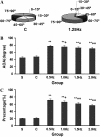
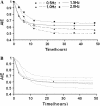



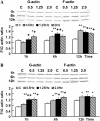
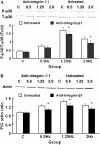
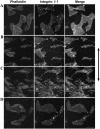
Similar articles
-
Mechano-active tissue engineering of vascular smooth muscle using pulsatile perfusion bioreactors and elastic PLCL scaffolds.Biomaterials. 2005 Apr;26(12):1405-11. doi: 10.1016/j.biomaterials.2004.04.036. Biomaterials. 2005. PMID: 15482828
-
[Effect of frequency of cyclic tensile strain on extracellular matrix of rat vascular smooth muscle cells in vitro].Sheng Wu Yi Xue Gong Cheng Xue Za Zhi. 2008 Aug;25(4):826-30. Sheng Wu Yi Xue Gong Cheng Xue Za Zhi. 2008. PMID: 18788289 Chinese.
-
Unraveling the role of mechanical stimulation on smooth muscle cells: A comparative study between 2D and 3D models.Biotechnol Bioeng. 2016 Oct;113(10):2254-63. doi: 10.1002/bit.25979. Epub 2016 Mar 28. Biotechnol Bioeng. 2016. PMID: 26987444
-
Regulation of vascular smooth muscle cells and mesenchymal stem cells by mechanical strain.Mol Cell Biomech. 2006 Mar;3(1):21-34. Mol Cell Biomech. 2006. PMID: 16711069 Review.
-
Tensile properties of vascular smooth muscle cells: bridging vascular and cellular biomechanics.J Biomech. 2012 Mar 15;45(5):745-55. doi: 10.1016/j.jbiomech.2011.11.014. Epub 2011 Dec 15. J Biomech. 2012. PMID: 22177671 Review.
Cited by
-
Cyclic Force Applied to FAs Induces Actin Recruitment Depending on the Dynamic Loading Pattern.Open Biomed Eng J. 2010;4:129-34. doi: 10.2174/1874120701004010129. Epub 2010 Jul 9. Open Biomed Eng J. 2010. PMID: 21611138 Free PMC article.
-
Cyclic stretch stimulates vascular smooth muscle cell alignment by redox-dependent activation of Notch3.Am J Physiol Heart Circ Physiol. 2011 May;300(5):H1770-80. doi: 10.1152/ajpheart.00535.2010. Epub 2010 Dec 17. Am J Physiol Heart Circ Physiol. 2011. PMID: 21169401 Free PMC article.
-
A dynamic stochastic model of frequency-dependent stress fiber alignment induced by cyclic stretch.PLoS One. 2009;4(3):e4853. doi: 10.1371/journal.pone.0004853. Epub 2009 Mar 25. PLoS One. 2009. PMID: 19319193 Free PMC article.
-
Cyclic Mechanical Stretch Up-regulates Hepatoma-Derived Growth Factor Expression in Cultured Rat Aortic Smooth Muscle Cells.Biosci Rep. 2018 Apr 27;38(2):BSR20171398. doi: 10.1042/BSR20171398. Biosci Rep. 2018. PMID: 29467272 Free PMC article.
-
Can repetitive mechanical motion cause structural damage to axons?Front Mol Neurosci. 2024 Jun 7;17:1371738. doi: 10.3389/fnmol.2024.1371738. eCollection 2024. Front Mol Neurosci. 2024. PMID: 38912175 Free PMC article. Review.
References
-
- Tranquillo, R. T., T. S. Girton, B. A. Bromberek, T. G. Triebes, and D. L. Mooradian. 1996. Magnetically orientated tissue-equivalent tubes: application to a circumferentially orientated media-equivalent. Biomaterials. 17:349–357. - PubMed
-
- Finlay, H. M., P. Whittaker, and P. B. Canham. 1998. Collagen organization in the branching region of human brain arteries. Stroke. 29:1595–1601. - PubMed
-
- L'Heureux, N., L. Germain, R. Labbe, and F. A. Auger. 1993. In vitro construction of a human blood vessel from cultured vascular cells: a morphologic study. J. Vasc. Surg. 17:499–509. - PubMed
-
- Standley, P. R., A. Cammarata, B. P. Nolan, C. T. Purgason, and M. A. Stanley. 2002. Cyclic stretch induces vascular smooth muscle cell alignment via NO signaling. Am. J. Physiol. Heart Circ. Physiol. 283:H1907–H1914. - PubMed
-
- Kanda, K., and T. Matsuda. 1993. Behavior of arterial wall cells cultured on periodically stretched substrates. Cell Transplant. 2:475–484. - PubMed
Publication types
MeSH terms
LinkOut - more resources
Full Text Sources

